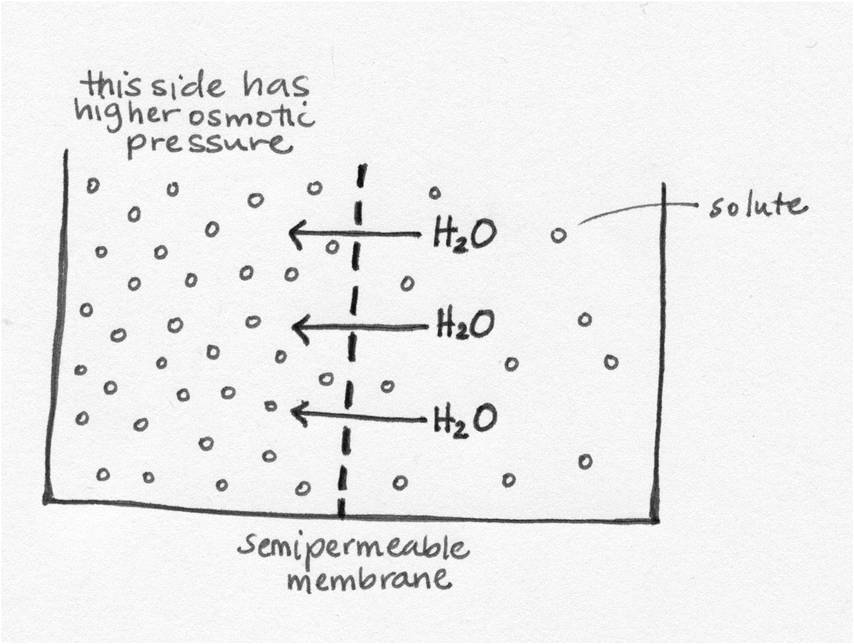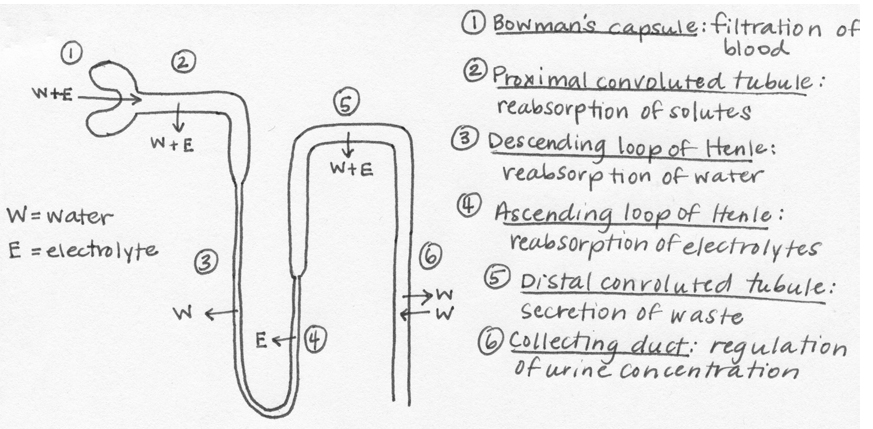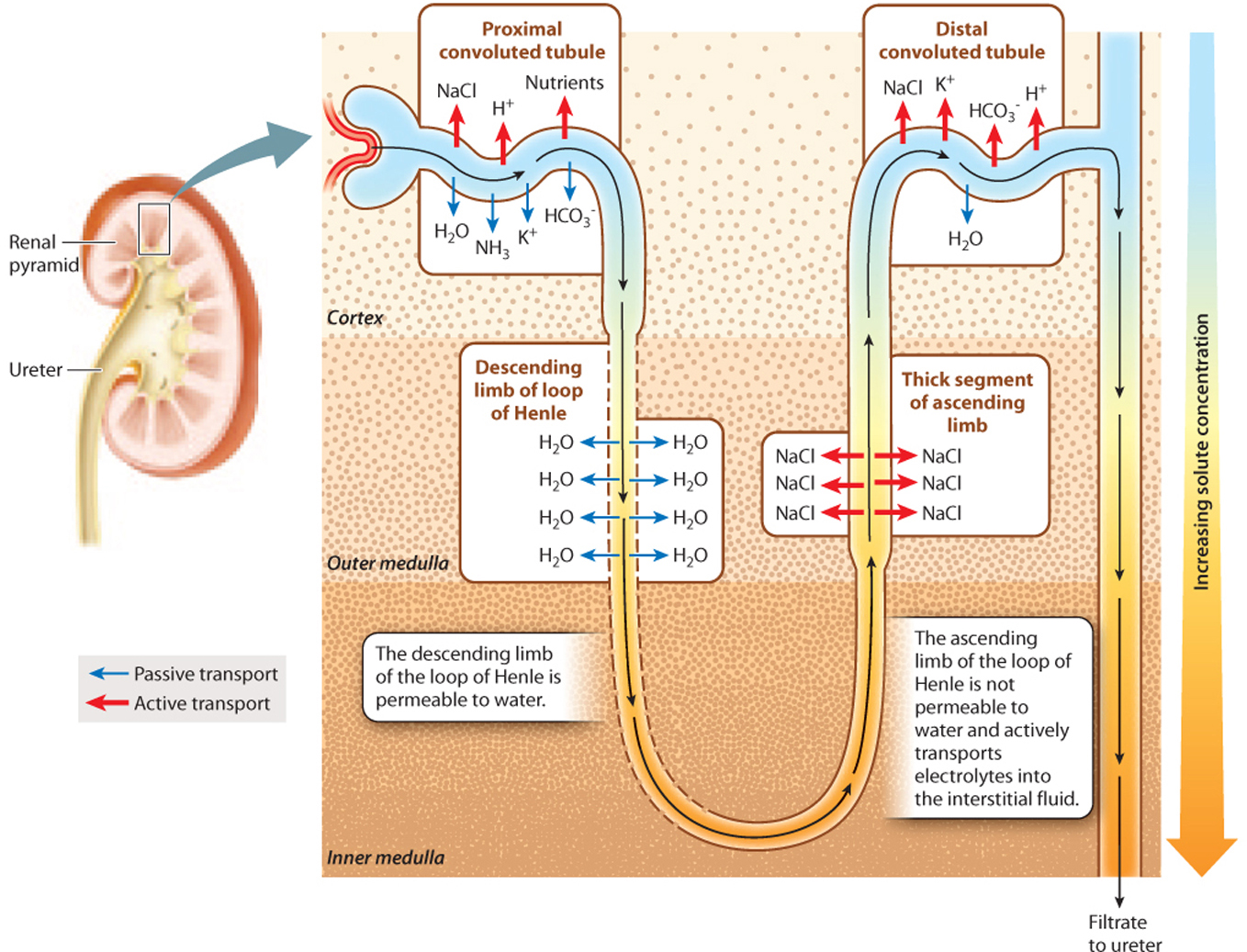CHAPTER SUMMARY
41.1 ALL ANIMALS REGULATE THE WATER AND ELECTROLYTE LEVELS WITHIN THEIR CELLS.
- Cell membranes and sheets of cells act as semipermeable membranes, allowing the passage of water but restricting or controlling the movement of many solutes.
- Water moves across semipermeable membranes by osmosis from regions of lower solute concentration to regions of higher solute concentration.
- Osmotic pressure is the pressure exerted by water as it moves from one solution to another by osmosis.
- Osmoregulation is the regulation of osmotic pressure inside cells or organisms.
- Osmoconformers maintain their internal solute concentration similar to that of the environment, whereas osmoregulators have internal solute concentrations different from that of the environment.
- Both osmoconformers and osmoregulators regulate the levels of particular solutes, especially sodium, potassium, and chloride.
- Osmoregulators that live in high-salt environments excrete excess electrolytes and minimize water loss.
- Osmoregulators that inhabit low-salt or freshwater environments excrete excess water and minimize electrolyte loss.
- Osmoregulators that live on land minimize water loss.
41-20
41.2 EXCRETORY ORGANS ELIMINATE NITROGENOUS WASTES AND REGULATE WATER AND ELECTROLYTE LEVELS.
- Osmoregulation and excretion are closely coordinated processes controlled by the excretory organs of animals.
- Ammonia, urea, and uric acid are three major forms of nitrogenous waste that animals excrete, depending on their evolutionary history and habitat.
- Ammonia is toxic but readily diffuses into water; urea is less toxic and can be stored before it is eliminated; uric acid is a semisolid and can be eliminated with minimal water loss as an adaptation for living on land.
- All animal excretory systems first isolate or filter fluid into an extracellular space. After being isolated or filtered, key electrolytes, solutes, and water are reabsorbed from the filtrate. Additional wastes are then secreted into the remaining filtrate before it is eliminated from the body.
- Examples of excretory organs are the protonephridia of flatworms, the metanephridia of segmented annelid worms, the Malpighian tubules of insects, and the kidneys of vertebrates.
- The urine produced by the kidneys and other excretory organs is stored in a bladder or the cloaca until being eliminated from the body.
- The functional unit of the vertebrate kidney is the nephron, which consists of a glomerulus, renal tubules, and collecting duct.
41.3 THE MAMMALIAN KIDNEY CAN PRODUCE URINE THAT IS MORE CONCENTRATED THAN BLOOD AS AN ADAPTATION FOR LIVING ON LAND.
- The kidney has an outer cortex and an inner medulla.
- The renal tubules have specialized regions, including the proximal convoluted tubule, the loop of Henle, and the distal convoluted tubule.
- The loop of Henle of some nephrons extends all the way into the medulla before looping back to the cortex. These nephrons create a concentration gradient from the outer cortex to the deeper medulla of the kidney.
- The ability to create a concentration gradient from the cortex to the medulla results from a countercurrent multiplier mechanism of the loops of Henle.
- The final concentration of urine is regulated by the control of water permeability within the walls of the collecting ducts, which pass from the cortex to the medulla.
- Release of antidiuretic hormone by the posterior pituitary gland increases the water permeability of the collecting ducts, concentrating the urine that empties from vertebrate kidneys.
- The kidneys help to regulate blood volume and pressure by secreting the hormone renin, leading to the production of angiotensin II, which constricts blood vessels, and aldosterone, which increases reabsorption of salt and water by the kidneys.
Self-Assessment Question 1
Given a semipermeable membrane that is permeable to water but not to a particular solute with different concentrations on the two sides of the membrane, show the direction of water movement and label the side with the higher osmotic pressure.
Show Model Answer
Model Answer:

Self-Assessment Question 2
Describe how animals gain and lose water and electrolytes.
Show Model Answer
Model Answer:
Animals gain water and electrolytes through drinking and the foods they eat. Freshwater animals also gain water through their gills. Additionally, water is generated by cellular respiration. Water and electrolytes are lost through urine, feces, evaporation from the lungs, and sweating. Most marine animals lose water through their gills as well. Specialized glands in some animals can also aid in removal of excess electrolytes.
Self-Assessment Question 3
Name two animals that are osmoconformers and two that are osmoregulators. Explain the difference between the two types of animal.
Show Model Answer
Model Answer:
Animals that regulate their internal osmotic pressure by maintaining their internal solute concentration at a level similar to that of their environment are considered osmoconformers, which includes animals such as sharks and marine invertebrates like sea stars. Many marine vertebrates are also osmoconformers, including hagfish, lampreys, rays, and coelocanths. All freshwater animals, including fishes and amphibians, and all terrestrial animals, including humans, are considered osmoregulators because they actively regulate their internal osmotic pressure, expending considerable energy to maintain an internal solute concentration that is different than that of their environment. The largest group of marine vertebrates, the teleosts, are also osmoregulators.
Self-Assessment Question 4
List three forms of nitrogenous waste and describe how each is an adaptation for the environment in which the animal lives.
Show Model Answer
Model Answer:
The three forms of nitrogenous waste are ammonia, urea, and uric acid. Ammonia is the nitrogenous waste produced by most aquatic animals, including many fishes. Although ammonia is highly toxic, fish can excrete waste in this form because it can be easily diluted in their aquatic environment; they don’t have to expend additional energy converting this waste into a less toxic form. Since terrestrial animals do not live in water, they must convert ammonia to less toxic forms of nitrogenous waste. Mammals, many amphibians, sharks, and some bony fish excrete nitrogen in the form of urea, which can be stored in a concentrated form and excreted with water in the urine. Urea is less toxic than ammonia but requires energy to produce it and water to eliminate it. For those animals that must conserve water, like those that live in hot, dry climates, the ammonia that is generated by the breakdown of proteins is converted into uric acid which is much less toxic and does not dissolve in water, so waste excretion can occur with limited water loss. Birds, insects, reptiles, and land snails excrete waste in the form of uric acid.
Self-Assessment Question 5
Describe the three steps in which organisms excrete wastes.
Show Model Answer
Model Answer:
Waste excretion happens through filtration, where solutes, waste, and water are removed from the blood; reabsorption, where water and necessary solutes are returned to the blood; and secretion, which allows excess solutes and toxins to be removed from the body in the filtrate.
Self-Assessment Question 6
Draw a mammalian nephron, label and describe the primary function of each part, and show the direction of water and electrolyte in each part.
Show Model Answer
Model Answer:

See also Figure 41.19.

Self-Assessment Question 7
Explain how the loop of Henle creates a concentration gradient from the cortex to the medulla. Describe the role of ADH in the regulation of urine concentration.
Show Model Answer
Model Answer:
Loops of Henle, which are long enough to descend into the medulla before looping back into the cortex, help to establish a concentration gradient based on their differential permeability to water and electrolytes. The descending loop of Henle is only permeable to water, so water moves out of the filtrate by osmosis into the interstitial space, which has a higher concentration of solute than the filtrate as it moves from the cortex to the medulla. The movement of water out of the loop of Henle in the descending limb results in concentration of the filtrate to match the concentration of solute in the interstitial space. As the filtrate then passes through the ascending loop of Henle, which is impermeable to water, electrolytes are pumped into the interstitial space to reduce the concentration of solute in the filtrate. This movement of ions out of the ascending loop of Henle restores the concentration of solute in the medulla and cortex.
Self-Assessment Question 8
Describe the role of ADH in the regulation of urine concentration.
Show Model Answer
Model Answer:
ADH affects urine concentration by altering the permeability of the collecting duct to water. In the presence of ADH, aquaporins are inserted into the membrane of the cells surrounding the collecting duct, increasing reabsorption of water and concentrating the urine. In the absence of ADH, the collecting duct is impermeable to water, so water remains in the filtrate and the urine is dilute.
Self-Assessment Question 9
Explain how the kidneys help to regulate blood volume and blood pressure.
Show Model Answer
Model Answer:
If blood pressure drops, cells within the juxtaglomerular apparatus release renin into the blood. This in turn leads to activation of angiotensin II, which causes blood vessels to constrict, increasing blood pressure due to the decreased diameter of the blood vessels. In addition, angiotensin II causes release of aldosterone, which triggers increased reabsorption of water and electrolytes in the distal convoluted tubule and collecting duct, leading to an increase in blood volume and blood pressure.